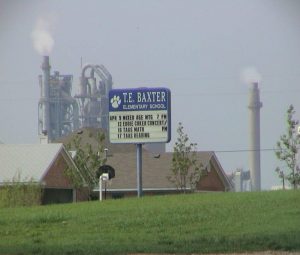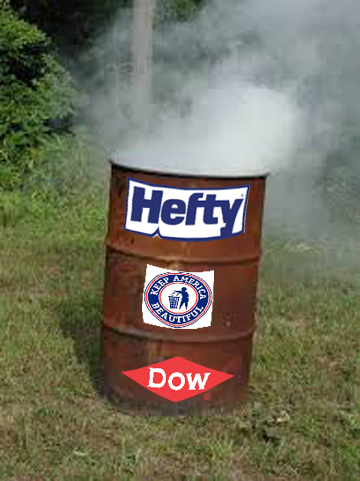Sulfur Dioxide
LafargeHolcim is a “Conscientious Corporate Citizen” Everywhere But Texas

In Europe, LafargeHolcim is a multinational cement manufacturer based in Switzerland and France – two countries on the cutting edge of climate crisis planning and members of the progressive European Union. The Company portrays itself as a climate-conscientious corporate citizen, to the point of its Swiss CEO declaring the reduction of CO2 emissions as his first, most important priority.
In Midlothian Texas, LafargeHolcim runs the most conventionally dirty cement plant in Texas and is seeking a permit that could make it one of the most climate-hostile one as well. In fact, there’s some reason to believe the Holcim plant in North Texas is preparing to burn by-products from either the Canadian Tar Sands, the Permian Oil Field, or both, as fuel.
Baking rock to make cement takes a lot of heat. Regardless of how new or old a cement kiln is, regardless of the pollution controls a kiln has, every cement maker in the world still has to employ the same age-old process of applying a 2000 degree open flame to a mix of limestone and other ingredients. A third or more of the cost of running a cement plant is keeping that open flame consistently hot enough to do the job.
This is the reason cement kilns will always try to find cheap, free, even profitable sources of fuel for that flame. Hazardous and industrial wastes that c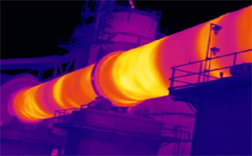 an be diverted from incinerators or landfills can be burned in cement kilns for slightly less money because they don’t have to meet the same standards. Used tires and oil. Lottery tickets. Dashboards from cars. Even municipal waste is now being burned in kilns.
an be diverted from incinerators or landfills can be burned in cement kilns for slightly less money because they don’t have to meet the same standards. Used tires and oil. Lottery tickets. Dashboards from cars. Even municipal waste is now being burned in kilns.
Burning anything causes air pollution. Burning wastes causes lots of conventional and exotic air pollution, including CO2. But just baking limestone rock also releases a lot of stored CO2. Even if there was some was to make cement without a flame, the heat needed would still release tons of CO2.
Worldwide the cement industry is estimated to be responsible for 5 to 7% of the planet’s CO2 emissions – larger then the airline industry. If the industry were a country, it would be the third largest emitter on earth, behind the United States and China.
Companies like LafargeHolcim are facing both public and financial pressures to reduce that number. In July European funds managing $2 trillion in assets called on cement companies to slash their greenhouse gas emissions, warning that a failure to do so could put their business models at risk. The mangers specifically mentioned LafargeHolcim and urged it to adopt the goal of net zero carbon emissions by 2050 and align itself with the Paris Climate Accords.
LaFarge Holcim has responded by initiating a series of technical innovations and pilot projects under the banner of “The Plant of Tomorrow” to prove its forward thinking.
Almost 300 facilities around the globe are targeted for inclusion in one or more of these “Plant of Tomorrow” projects, including a Canadian kiln installing a carbon-capture pilot project, an Ohio kiln building three wind turbines to secure its electrical needs, and kilns burning industrial waste as “low carbon” (if not low toxic) fuel.
Left out of this mix so far is Holcim’s woe-be-gone Midlothian plant. You might call it Holcim’s “Plant of Yesterday.” Despite having lots of stiff competition, Holcim not only operates the dirtiest cement plant out of the three doing business in Midlothian, but it’s the dirtiest in the entire state.
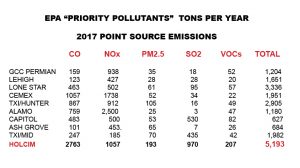
Holcim’s Midlothian plant is the largest Carbon Monoxide (CO) polluter among all 10 Texas cement plants – a sign of poor combustion. It’s the second largest Nitrogen Oxide (NOx) polluter among the bunch, emitting almost twice as much smog pollution as the other two Midlothian cement plants combined. It’s the largest PM 2.5 (Particulate Matter) polluter by far – almost 100 tons a year separate it from second place. It’s the largest Sulfur Dioxide (SO2) polluter by a large margin and releases four times as much Volatile Organic Compounds (VOCs) than the next highest plant. Almost all 2017 pollution numbers for Holcim have gone up over the last five years. A plant that was already bad is getting worse.
Now add Holcim’s request for a new permit to burn 100% Petroleum Coke in one of its two kilns.
Pet Coke is a byproduct of oil refining. It’s a concentrated carbon solid residue that is left behind after the refining process has converted the bulk of the oil into liquid fuels such as gasoline and diesel.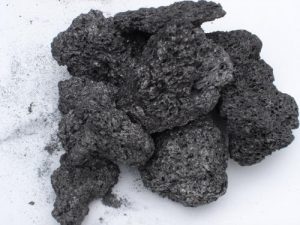
Pet Coke is like coal, but dirtier. Pet Coke looks and acts like coal, but it has even higher carbon emissions than coal. On a per-unit of energy basis Pet Coke emits 5 to 10 percent more carbon dioxide than coal. A ton of Pet Coke yields on average 53.6 percent more co2 than a ton of coal.
As well as significantly higher co2 emissions, Pet Coke also has high sulfur and toxic metals content than coal.
Because its a waste product, Pet Coke is cheap for Holcim to buy or it could even be free if a refinery wanted to get rid of its supply. And now, thanks to the exploitation of the Tar Sands and the oil boom in the Permian the US has lots and lots of Pet Coke. The heavy oil refining capacity in America is now the largest in the world, with over 40 percent of the global market. Much of that production takes place on the Texas Gulf Coast in huge new expanded refinery complexes like Motiva and Total in Port Arthur. The capacity to produce Pet Coke in U.S. refineries has doubled since 1999. In fact, the annual production of Pet Coke is so large these days, it’s outstripped most of the usual uses for it and is “priced to move.”
Because Holcim wants to burn 100% Pet Coke, and it must have a reliable source to burn it 24/7, there’s reason to believe the company has signed a sweetheart deal with one or more refineries to supply it. Probably from the Gulf Coast, and probably from one of the refineries dealing in Canadian Tar Sands oil or Permian Basin product. Both are poster boys for irresponsible fossil fuel development with the Tar Sands and the Keystone Pipeline igniting modern Climate Crisis activism and the Permian becoming one the planet’s largest sources of Methane as tons of unused natural gas are burned off from thousands of rigs.
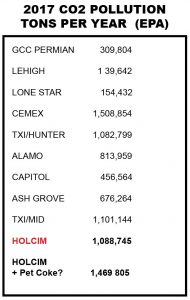 Currently, Holcim is “only” the third largest CO2 polluter among all ten cement plants in Texas, and fourth among all of Holcim’s U.S. plants. But burning 100% Pet Coke in its Kiln #2 could change that rapidly by adding a whopping 400,000 tons more of CO2 to its annual totals. That would send it to #2 in Texas and #2 in the entire US Holcim fleet of cement plants. Not very climate conscientious. And probably not a number you want to tout in trying to sell your “Plant of Tomorrow.”
Currently, Holcim is “only” the third largest CO2 polluter among all ten cement plants in Texas, and fourth among all of Holcim’s U.S. plants. But burning 100% Pet Coke in its Kiln #2 could change that rapidly by adding a whopping 400,000 tons more of CO2 to its annual totals. That would send it to #2 in Texas and #2 in the entire US Holcim fleet of cement plants. Not very climate conscientious. And probably not a number you want to tout in trying to sell your “Plant of Tomorrow.”
At the same time Holcim is trying to project an image of a concerned 21st Century corporate entity to the rest of the world, it’s doing business in Texas like its still 1999.
Officially, the State of Texas doesn’t care about CO2 pollution. Heck, officially it doesn’t even believe there’s a climate crisis. There is no regulatory system for controlling its releases and only the EPA bothers to track CO2 releases at all. So this increase in planet-melting pollution will go completely unaddressed in the permit proceedings themselves.
Also officially, despite the evidence, the State and Holcim both say no other kinds of pollution will increase when 100% Pet Coke is burned at Holcim. No increase in PM 2. 5. No increase in SO2. No increase in metals. Citizens don’t believe them. A group calling itself “Midlothian Breathes” has formed to fight the new permit and has already caught regulators off guard asking tough questions about new emissions.
But trying to get the State of Texas to do the right thing about air pollution is an uphill fight. Instead, perhaps citizens should take these embarrassing numbers directly to LafargeHolcim, who’s claims of new fund corporate responsibility are belied by them. Contrasting its Texas operations with those of the rest of its facilities may be a way to shame the company in its own European backyard. Officially the company may still be able to be embarrassed. Texas state government left that possibility behind years ago.
DFW Holcim Cement Plant Seeks to Burn 100% Petroleum Coke
Increases Predicted in Air Pollution, including 100 more tons of PM a Year
Holcim Cement’s Midlothian cement plant has requested a permit application to the Texas Commission on Environmental Quality to release an additional 2700 tons per year of Carbon Monoxide and burn 100% Petroleum Coke in its Kiln #2. Holcim estimates these change will set of federally-mandated reviews for increases in emissions of Particulate Matter (PM), Nitrogen Oxide (NOx), Sulfur Dioxide (SOx), and Carbon Monoxide (CO).
Notice of the company’s permit amendment was published in the Midlothian Mirror earlier in the  month.
month.
Holcim is one of three very large cement plants doing business just south of I-20 in Midlothian in what is the largest concentration of cement manufacturing in the U.S. The other two are TXI and Ash Grove. These are not batch plants. These are where the batch plants get their product. With annual air pollution emissions in the thousands of tons, any one of these kilns would easily be the largest “stationary” industrial source of air pollution in North Texas. Combined, they represent a mega source of air pollution for DFW.
Review of the numbers in the permit application show the company wants to scrap its current limit of a little over 4000 tons a year for Carbon Monoxide and replace it with a higher 7112 ton per year ceiling. In addition, the difference between actual emissions and proposed changes could result in 100 tons more of Particulate Matter, 260 more tons of smog-forming Nitrogen Oxide, and 1700 additional tons of Sulfur Dioxide.
 Missing from the permit analysis is the impact of the changes on CO2 climate crisis pollution. Petroleum Coke is nothing but carbon. It releases a lot of CO2 when burned. Burning 100% Petroleum Coke at Holcim will significantly increase this kind of air pollution. Cement plants are already a huge source of CO2 worldwide and Texas leads the country in CO2 pollution.
Missing from the permit analysis is the impact of the changes on CO2 climate crisis pollution. Petroleum Coke is nothing but carbon. It releases a lot of CO2 when burned. Burning 100% Petroleum Coke at Holcim will significantly increase this kind of air pollution. Cement plants are already a huge source of CO2 worldwide and Texas leads the country in CO2 pollution.
Overall, it’s the largest requested air pollution increase from any of the three Midlothian kilns in a very long time. And it reveals how badly the snake-bit 20th Century Holcim plant is aging.
Holcim’s current air pollution levels are already way out of sync with the other two, newer cement plants in Midlothian, and the Holcim facility has had a long troubled history with what its owners claim is a problem with the area limestone – the same patch of limestone the other two plants use. Holcim is already releasing 14 times the amount of four major air pollutants compared to Ash Grove’s 2014 renovated plant, and three times the amount of those same pollutants as TXI. This permit amendment would make the difference even starker.
Clearly Holcim has a problem child cement plant. Since Kiln #1 opened in 1999 it’s never performed to expectation. Because it would otherwise have set off a national non-attainment area for Sulfur Dioxide, Holcim had to add scrubbers to the plant before it even opened. When Kiln #2 was added in 2000, Holcim predicted it would cut pollution in half. Instead it doubled air pollution and by EPA decree the company had to add new pollution controls and buy Downwinders at Risk an independent scientist to monitor their operations. Now Holcim is saying their longstanding plan to reduce Carbon Monoxide pollution at that second kiln just didn’t work out and they need to increase their CO “permit allowables” by over 2700 tons a year.
Even for a very large cement plant, that’s a significant increase in pollution. CO pollution is a red flag for poor combustion, which is always worrisome when you’re looking at a facility of Holcim’s size that’s burning a flame at 2400 degree flame 24/7/365. Poor combustion at a cement plant burning tires and industrial waste, as Holcim does, or even coal and Petroleum Coke, means the creation of more “Products of Incomplete Combustion,” or “PICs.”
PICs are bad news. Dioxin – the poison in Agent Orange – is a PIC but there are thousands more. Some are extremely toxic. Holcim is already releasing 168 times more CO than the newer Ash Grove plant – located just across Highway 67, and nine times more than former Bad Boy TXI. That’s a lot of potential PICs. Something isn’t right in the basic design of the plant to make it so inefficient, but instead of investing in a new plant, Holcim just wants to increase its pollution levels.
There’s a second part of Holcim’s request that’s even more disturbing. Besides the increase in CO pollution, Holcim is seeking approval from the State to burn 100% Petroleum Coke as a fuel for its Kiln #2.
Cement kilns need a cheap source of fuel. Since 1960 the Midlothian kilns have burned gas, coal, hazardous waste, tires, used oil, car inards, plastic packaging, and other “industrial wastes” to keep a flame at 2400 degrees F or hotter. But never 100% Petroleum Coke.
Pet Coke is a refinery waste high in BTU value and sulfur content. It’s very dirty. It’s basically solid carbon. In the application submitted by Holcim, the company says Particulate Matter pollution could go up by 100 tons per year. There’s also a very good chance of increases in smog-forming Nitrogen Oxides and Sulfur Dioxide pollution. Separately there’s also a significant but undocumented increase in CO2 that will occur because of Pet Coke’s composition, so this is a very bad Climate Crisis move as well.
Holcim says not to worry – most of these increases are on paper only and they’re not really changing the emissions, just “refining them.” But with the plant’s history, it’s more likely air pollution will increase, and not by a little bit.
TCEQ’s permit engineer assigned to the Holcim case says this is only a preliminary application and that the company will have to answer more questions about pollution increases, and more importantly will have to stage a “test burn” to see what the impact of burning 100% Pet Coke will actually be (under ideal conditions when everyone is looking over their shoulder). Many long time observers of the modern TCEQ under Governor Greg Abbott are skeptical any of this will happen before Holcim gets their permit however.
Because of the increased volumes of pollutants, this application will be generating an official response from Downwinders requesting at least one public meeting for a briefing on the permit and objecting to any increase in PM and NOX, insisting on test burns using 100% Pet Coke before the permit is approved, and protesting any increase in Climate Crisis pollution.
There’s two responses you can take right now to oppose Holcim’s permit amendment:
1) You can request a public meeting in Midlothian to have the TCEQ and company brief the public on the permit amendment and have the opportunity to ask questions
CLICK HERE TO SEND AN EMAIL NOW TO THE TCEQ
AND ALL LOCAL STATE REPRESENTATIVES AND SENATORS
Requests should be addressed to the Texas Commission on Environmental Quality as well as local State Representatives and Senators – not just those representing Midlothian.
TCEQ:
By email:
https://www14.tceq.texas.gov/epic/eComment/
bbohac@tceq.state.tx.us
By mail:
TCEQ, Office of the Chief Clerk, MC-105, P.O. Box 13087 Austin, Texas 78711-3087
Texas State Senators
St. Senator Brian Birdwell/Midlothian: Brian.Birwell@senate.texas.gov, 512-463-0122
St. Senator Royce West/Southern Dallas County: royce.west@senate.texas.gov 512-463-0123
St. Senator Beverly Powell/ Southern Tarrant County: beverly.powell@senate.texas.gov 512-463-0110
Texas State Representatives
Rep. John Wray/Midlothian: john.wray@house.texas.gov 972-938-9392
Rep Yvonne Davis/ Southern Dallas County: yvonne.davis@house.texas.gov 512-463-0598
Rep. Carl Sherman/Southern Dallas County: carl.sherman@house.texas.gov 512-463-0953
Rep. Chris Turner/ Southern Tarrant County/Arlington: Chris.Turner@house.texas.gov 512-463-0574
Contact all of these folks individually, or you can send them and the TCEQ the same email requesting a public meeting on Holcim’s permt via Downwinders’ ClickNSend feature. Leave your own personal message too.
2) Request a Contested Case Hearing
If you feel you’ll be affected by Holcim’s new air pollution, you have a right to ask for a contested case hearing – a formal legal proceeding that sets a higher bar for Holcim to get a permit. In order to request a Contested Case hearing, you must send the TCEQ Chief Clerk:
1) YOUR NAME, or GROUP NAME
2) MAILING ADDRESS AND TEL #
3) APPLICANT’S NAME AND PERMIT #: Holcim, Air Quality Permit 8996 and PSDTX454M5
4) THIS EXACT STATEMENT: ” I/We request a contested case hearing.”
5) A DESCRIPTION OF HOW YOU WILL BE HARMED BY HOLCIM’S AIR POLLUTION
6) THE LOCATION OF YOUR HOME OR BUSINESS AND THE APPROXIMATE DISTANCE TO THE HOLCIM CEMENT PLANT TO THEM.
7) A DESCRIPTION OF HOW YOU USE THE PROPERTY AFFECTED BY HOLCIM’S AIR POLLUTION (HOME OR BUSINESS OR RECREATIONAL)
8) A LIST OF DISPUTED ISSUES
Example: 1. Any increase in PM Pollution from Holcim will be harmful to my health and enjoyment of my property, 2. There has been no evaluation of the PM, NOx, SOx, or CO emissions of burning 100% Petroleum Coke in Kiln #2, 3. There has been no evaluation of the burning 100% Petroleum Coke in Kiln #2 on increase in CO2 4. Holcim’s cement plant isn’t applying Best Practices and Best Available Control Technology for emission reductions of PM, CO, NOx, and SOx.
Send your request to the TCEQ’s Chief Clerk:
By email:
https://www14.tceq.texas.gov/epic/eComment/
bbohac@tceq.state.tx.us
By mail:
TCEQ, Office of the Chief Clerk, MC-105, P.O. Box 13087 Austin, Texas 78711-3087
We Won! Dallas Plan Commission Votes 7-3 to Deny Approval of Bird Lane Batch Plant
It’s the 5th time in the last 13 months residents of
South and West Dallas have beaten back City staff attempts to put more polluters in their backyards
But this time they had to take on
their own Council Member and Plan Commissioner.
Channel 5 Coverage
City Hall Videotape Plan Comm. Mtg
(batch plant case begin about 20 minutes in)
In one of the most impressive recent displays of South Dallas neighborhood empowerment, residents won their fight last Thursday at the Plan Commission to keep yet another batch plant from setting-up shop among them.
But unlike past battles, they had to overcome their own Council member and his Plan Commissioner to do it.
Residents, as well as representatives from the Joppa Freedman Township Association, Paul Quinn College, the Inclusive Communities Project, and Downwinders at Risk all spoke out against the idea of transforming another piece of South Central Expressway property into a hub of heavy industry.
Leading the other side in support of the Bird Lane batch plant was of course the company proposing it, Estrada Concrete, and their consultants, but also District 8 Council Member Tennell Atkins’ Plan Commissioner, Chris Lewis. Bird Lane is in District 8.
Usually the support or opposition of the home district Council Member and Commissioner is key to the final tally, but in this case, the strength of the case against the plant was so solid, and Lewis’ plea to approve it so feeble, that a majority of his peers rejected his request. As these things go, it was a huge, humiliating smack down.
Lewis’ anti-citizen stance is more shocking once you know that only five days earlier he’d assured District 8 residents he’d be voting against the batch plant. Instead, the moment the last of the opposition speakers finished (there were no residents speaking in favor), he immediately made a motion to approve the batch plant.
Needless to say, that turn of events caught everyone opposing the plant off guard and provoked a rowdy backlash in the audience that built until the final vote was taken.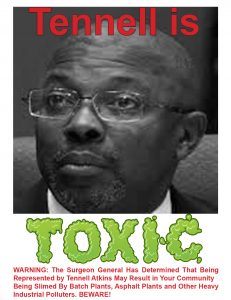
If it hadn’t been for District 11 (Kleinman) Commissioner Jaynie Schultz, District 3 (Narvaez) Commissioner Deborah Carpenter, District 5 (Callahan) Commissioner Tony Shidid, and District 1 (Griggs) Commissioner Jarred Davis raising objections, asking hard questions, and pointing to specific guiding language in the Dallas Planning Code, the vote would have gone against neighbors. In other words, there were at least four other Commissioners doing the work on behalf of District 8 residents that Mr. Lewis was appointed to do. Both Kevin Felder’s and Casey Thomas’s slots on this important body are currently MIA because they haven’t yet named replacements for their departed Commissioners.
That’s not a traditional liberal-conservative alliance that defeated the batch plant– you won’t find Scott Griggs and Rickey Callahan tossing back beers together. Nor is it a strictly black and white split. Of the two black Commissioners present, the only one voting for the batch plant was Mr. Lewis.
It was a neighborhood/Citizens Council split.
Not in any “big” issue, lots-of-phone-calls-before-the-vote kind of way. Rather, in a small, looking-out-my-own-backdoor kind of way.
Commissioners who opposed the batch plant couldn’t imagine looking out their own doors and seeing this thing as a neighbor. Those voting in favor knew such a fate was impossible for them.
Final proof is found in looking at who voted in favor of Lewis’ original motion to approve the batch plant. It included longtime Dist 15 (Rawlings) Commissioner Gloria Tarpley who’s distinguished herself in the past by voting for illegal gas drilling, and the Commissioners from Districts 13 (Gates), and District 10 (McGough).
As per usual, Dallas City staff had recommended approval of the Bird Street Batch plant, so residents really were fighting the entirely of City Hall – including the guy that’s supposed to be their full-time advocate at the place. And yet they persisted. And they won.
As it happens, the knock -out was a twofer. Not only did District 8 residents defeat the Bird Street batch plant, but they also learned that plans for Estrada’s other proposed batch plant around the corner on Zonie Road were being pulled as well.
Their victory – your victory too thanks to over 100 emails of opposition sent through our Citizen Action portal – was one event in a series of recent events that have given environmental justice issues in South Dallas some real traction of late. The first Joppa batch plant fight last March, announcement of the new Superfund site near Paul Quinn, discovery of Marsha Jackson’s “Asphalt Alps,” and other open wounds are beginning to provoke community self-defense responses.
Whether those responses can overcome South Dallas business as usual at the ballot box in May, or produce systematic change at City Hall, is a large and important question not only for South Dallas, but Dallas as a whole. We all live in neighborhoods. We all live downwind.
Brown, Big: 1971-2018
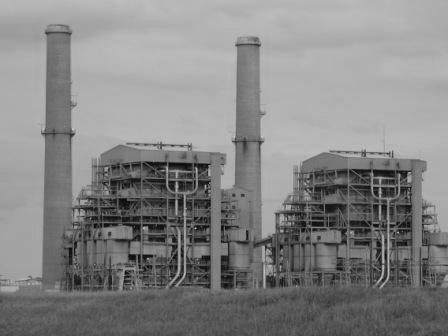 After years of declining fiscal health, the Big Brown lignite coal plant finally succumbed last Friday. An announcement was made by its most recent caretaker, Vistra Energy last Friday morning. The cause of death was obsolescence. It was 47.
After years of declining fiscal health, the Big Brown lignite coal plant finally succumbed last Friday. An announcement was made by its most recent caretaker, Vistra Energy last Friday morning. The cause of death was obsolescence. It was 47.
Controversial from its birth, the 1. 2 Gigawatt Big Brown lived up to its name and was Texas Utilities’ flagship power plant for decades. It began by burning 100% Lignite Coal, the mud-like fossil fuel native to East and Central Texas. By the end however, it was importing thousands of tons of “cleaner” Wyoming Powder Basin Coal in long freight trains to comply with interstate pollution rules.
Along with other coal-fired power plants in East Texas, Big Brown was citied for causing acid rain to by SMU Chemist George Crawford as early as the 1980’s. It was then discovered to be a major contributor t0 Dallas-Fort Worth smog, a fact reinforced by a 2008 study from another SMU professor and former EPA Regional Administrator Dr. Al Armendriz, and more recently by Dallas Medical Society’s Dr. Robert Haley in his 2015 report on ozone levels and public health in DFW. Public Citizen/Texas and the Sierra Club had been particularly hostile to the plant’s continued operation.
As coal lost favor as an energy source, Big Brown’s estimated lifespan had been the subject of countless rumors over the last decade. Towards the end the plant consistently refused modern technology which might have prolonged its life, such as Sulfur Dioxide scrubbers and Selective Catalytic Reduction for smog pollution.
The timing of the plant’s demise was seen as a major embarrassment to officials in the Trump Administration, who’ve promised to promote coal. On the same day as Vistra’s notice about Big Brown’s demise, Trump appointed known fossil fuel promoter Kathleen Hartnett White to lead the White House Council on Environmental Quality.
It was the third Texas coal plant to expire in less than a week. Big Brown was preceded in passing by the Monticello lignite plant, which announced its departure on October 6th. Vistra said its smaller Sandlow power plant near Bastrop was to be closed in 2018 as well.
In 2016, these three coal plants emitted a total of 166 million pounds of sulfur dioxide, 24 million pounds of nitrogen oxide, and 21 million tons of carbon dioxide pollution. Their absence during the 2018 “ozone season” could be the first time DFW stands a chance of complying with the Clean Air Act in 27 years.
Survivors, for now, include the coal-fired Martin Lake and Oak Grove power plants, as well as NRG’s Limestone power plant, southeast of DFW.
HEFTY! HEFTY! HEFTY! is TOXIC! TOXIC! TOXIC!
Anti-Litter Group “Keep America Beautiful” Teams-Up with Dow and Hefty to Burn Plastic Bags Full of Plastic Garbage in Cement Kilns
And They Want To Do It Here…
We’ve been warning you for a while that garbage burning was coming to North Texas one way or another.
What we didn’t anticipate was that “Keep America Beautiful” would bring it.
That’s right. The same group that gave you Oscar “Iron Eyes” Cody crying over litter is now prepared to make your own eyes water and sting from the air pollution it wants to encourage by burning municipal solid waste, especially “hard-to-recycle” plastics.
Touting bright orange “energy bags” as a quick and easy alternative to throwing those plastics away, a news release issued by the Keep America Beautiful folks, your friends at Dow Chemical, and Reynolds, the makers of “Hefty” trash bags, claims they’re “a convenient way to collect plastic materials that would otherwise end up in the landfill and offers a platform to promote positive behaviors to prevent this material from being wasted.”
What they don’t tout as much is their alternative to throwing these plastics into a landfill – throwing them into a furnace.
As long as cement kilns need a high-temperature flame to make their product, they have large energy costs. Typically, 30% or more of the costs of running a cement plant is in buying the flammable materials necessary to keep that flame lit.
 History has taught us that cement kiln operators will burn anything, including the kitchen sink, if they think it will help reduce those high fuel costs.
History has taught us that cement kiln operators will burn anything, including the kitchen sink, if they think it will help reduce those high fuel costs.
Kiln flames in Texas used to be powered by natural gas exclusively. Then it was coal. Then it was hazardous waste and coal. Then industrial wastes. And now municipal solid wastes. In bright orange plastic bags.
Cement plants don’t have to pay for the wastes, now termed “fuel,” for regulatory loophole purposes. In fact, because it’s now a “fuel,” they often get the waste for free or even get paid to burn it. It becomes a new center of profit in the company besides making cement. Maybe even more important. In the 1990’s, there were plenty of rumors about how the TXI cement plant in Midlothian would burn a lot of hazardous waste they got paid a handsome fee to take, but not have much cement product to show for it.
While garbage burning cement kilns have been on the rise in the developing world, the practice hasn’t caught on in the U.S.
Dow’s and Keep America Beautiful’s friendly neighborhood “Energy bags” are a way to jump start it.
This is already happening in Omaha, where 8,500 homes have filled 13,000 “Hefty Energy Bags” since the program’s launch in October. That’s resulted in more than 13,000 pounds of plastics being burned in a near-by Ash Grove cement kiln. They’re so excited about burning plastics at Keep America Beautiful that they’re not only endorsing the practice, they want to bring it to a cement kiln near you.
At a news conference to announce the offering of cash money grants to local communities who wanted to try the option, they unveiled a contiguous states map of the US where they’d like to see the “energy bag” concept implemented. The approximately 50 locations on the map identified by a red (not orange?) star are almost all sites adjacent to large cement plants – including Midlothian, immediately south of the Dallas and Tarrant Counties line, and home of the largest concentration of cement manufacturing in the nation.

Local candidates for eager participation in the project include TXI, the cement plant that burned hazardous waste by the thousands of tons from 1987 to 2008, Holcim, which has sought permits to burn carpet scraps and shingles, and Ash Grove, the same operator as the one burning Omaha’s plastic bags now.
BURNING PLASTIC IS BAD FOR PUBLIC HEALTH AND PUBLIC POLICY
1. It replaces real recycling with burning.
Once you have a hungry garbage burner, you have to keep feeding it with more and more garbage, decreasing the market for real recycling.
This is already happening with tires. There are good tire recycling programs that can’t stay afloat because local governments have promised the local cement kilns a certain volume every year.
2. It gives an incentive to the plastics industry keep to just making plastics that you can’t recycle.
Burning plastic garbage is like a relief valve on the growing piles of “hard to recycle” plastics that industry is producing. Just throw it in a bag and send it to the kiln. Out of sight, out of mind. There’s no question it reduces the percentage of plastics going to landfill…only to increase the percentage of plastic going into your lungs.
The real answer is to reduce and quit producing those “hard-to-recycle” plastics, not giving them a cheap way to get out of doing so.
3. Burning plastic produces lots of toxic air pollution – and all of DFW is downwind of Midlothian
Burning plastics produces toxic air pollution, a percentage of which escapes the smokestack and ends up in the air you breathe, the soil in your garden, and the food you eat and drink. Specifically, burning plastic creates lots of Dioxins and Furans – the same ingredients that made Agent Orange so toxic. The same poisons that made the State of Missouri evacuate the town of Times Beach in 1983.
Burning plastic also releases metals into the air, like cadmium and lead.
Other chemicals released while burning plastics include benzo(a)pyrene (BAP) and polyaromatic hydrocarbons (PAHs), which have both been shown to cause cancer. If plastic film or containers are contaminated with pesticides or other harmful substances, those will also be released into the air. If plastics are burned with other materials, whole new toxic chemicals may be created from the interaction of the different substances.
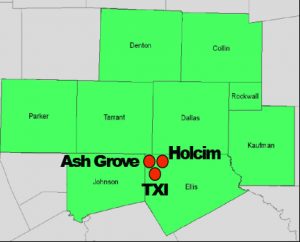
But wait! Don’t you want to divert more garbage from going to landfills?
Yes you do, but by eliminating, reducing and recycling the garbage – not taking a match to it.
Landfills are nasty things. They’re big and smelly and they leak. Sometimes they leak and contaminate ground and surface water. But these days you usually can trace the plume of those leaks and contain them before they get in drinking water.
On the other hand, once a piece of dioxin-contaminated soot is shot through a smokestack into the atmosphere, you have no idea where it’s going. You’re turning the whole sky into a landfill, full of solid and gaseous residues of refuse. What you didn’t want to drink, you’re now breathing. That’s the opposite of progress.
Taking a look at the Board of Directors for Keep America Beautiful, it’s no wonder they have a soft spot in their heart for large plastics manufacturers. They have not one, but two members from DOW, who, we are sure, thought this was a splendid idea.
Howard Ungerleider is Vice Chairman and Chief Financial Officer of Dow, and Greg Jozwiak is the Business President for the Elastomers and Electrical and Telecommunications businesses for the company. Prior to assuming his current role, he served as North America Commercial Vice President for the Packaging & Specialty Plastics business. Hmmmm.
But wait, there’s more! KAB has a board guaranteed to offend just about everyone. Not content with two Dow executives, it also has two Nestle Corporation members, a representative of Waste Management Inc., McDonalds, Keurig, Anheuser-Busch, and Phillip Morris – yes, that Phillip Morris.
“PEOPLE START POLLUTION. PEOPLE CAN STOP IT.”
Those are the words, spoken in a deep baritone by William “Cannon” Conrad, that ended that famous 1971 Keep America Beautiful commercial in honor of Earth Day. They ring as true now as then.
And so, people, we’re asking you to take action to discourage this kind of BAD IDEA from ever coming-up at a Keep America Beautiful board meeting again – send an email to their new Chair, Helen Lowman.
Ms. Lowman is a former FEMA and Peace Corps executive in the Obama Administration. She’s from Texas, worked at TCEQ, and graduated from Austin College…. So maybe messages from her fellow Texans will have more of an impact.

TAKE ACTION:
TELL KEEP AMERICA BEAUTIFUL’s NEW CHAIR YOU DON’T WANT TO BREATHE TOXIC AIR POLLUTION FORM BURNING PLASTICS
SEND AN EMAIL WITH JUST TWO CLICKS
And if you want to leave a public message for the group too, here’s the group’s FaceBook site.
Other citizens groups, including some national alliances and networks are gearing up to take on this latest proof that all wastes, no matter how toxic, roll downhill to cement kilns eventually.
Meanwhile, Downwinders is taking the lead and beginning the push back we hope buries this project in the bright orange trash heap of history. Join us in not just saying “No,” but “Hell No.” Send that email now and then find two other people that will do the same. Thanks.
EPA Rejects Texas’ BS and Submits Its Own Air Plan for Parks. Will It Do the Same For People?
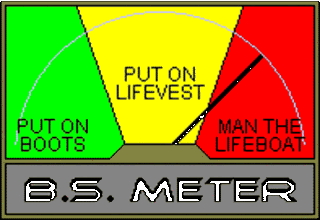 As you might have already heard, last week the EPA announced it was rejecting Texas' proposed rapid-response,140-year plan for restoring air quality and visibility in National Parks affected by pollution from the state's largest industrial facilities, primarily coal-fired power plants, aka, "the haze rule."
As you might have already heard, last week the EPA announced it was rejecting Texas' proposed rapid-response,140-year plan for restoring air quality and visibility in National Parks affected by pollution from the state's largest industrial facilities, primarily coal-fired power plants, aka, "the haze rule."
Instead, the EPA decided to implement its own, slightly more decisive plan for action. Whereas the state concluded it needed no new controls on any coal plants, the EPA is requiring modern Sulfur Dioxide (SOx) scrubbers on 14 different boilers at nine power plant sites across the state it estimates will remove 230,000 tons of the pollutant annually. That's 60% of the state's total SOX pollution, and 7% of the nation's.
These scrubbers not only capture SOx on behalf of more beautiful vistas in Big Bend, they also do a good job of preventing lots of Particulate Matter pollution from reaching the lungs of people that live in between the coal plants and parks. Although computer modeling was used by EPA to determine the effectiveness of the scrubbers it's requiring, it focused on results inside the parks. Getting results for metro areas like DFW involves a lot of data mining nobody has done, but there's no question that if reductions in air pollution are helping Oklahoma and West Texas parks, they're also helping out the air in North Texas. Just one look at the modeling maps produced by our recent UNT study of DFW ozone shows the immense impacts of these plants on DFW air quality.
For residents of DFW, the reductions in pollution are overdue and welcome news (the process leading up to this rule can be traced all the way back to 1977), and it certainly makes it even less likely that the big bad old TXU plants (Big Brown, Monticello and Martin Lake) can escape their obsolescence after bankruptcy proceedings.
But the way the EPA determined to go it alone in this case may be much more important to DFW's own air quality in the long run as the actual reductions it implements.
Not to put too fine a point on it, but EPA called BS on the way Texas was obscuring the data needed to write a good haze rule plan. This M.O. sounds awfully familiar to citizens watching the way the State has drafted its anti-smog plan for DFW, now officially approved by the TCEQ Commissioners and on its way to a public hearing in Arlington on Thursday, January 21st (6 pm, HQ of North Central Texas Council of Governments, 616 Six Flags Road).
And if EPA is willing to stand-up to Texas over air quality in parks, shouldn't it take at least as strong a stand on behalf of seven million souls in DFW?
About the same time EPA was announcing a federal takeover of the haze rule plan, Downwinders released its new video appealing for help from the EPA to reject the State's do-nothing smog plan for DFW. A big part of our case is its reliance on faulty analysis and downplaying or obscuring evidence that contradicts the state's ideological position that no new pollution controls for smog are needed in a region in its third decade of continual violation of the Clean Air Act and after a summer where smog averages increased…twice.
Which makes the language EPA uses to justify this takeover of the haze rule plan all the more relevant, and gives residents some hope should the Agency apply the same logic to the State's pathetic response to DFW's chronic smog problem.
EPA accuses Texas of hiding the most effective control strategies from EPA and Oklahoma (where the Wichita Mountains Wildlife Refuge is affected by Texas-based pollution seven times as much as Oklahoma-based SOx) by flooding its emissions inventory data with both large and small sources of SOx from across the state, washing out the impact of the larger coal plants.
"During the interstate consultation required by the Regional Haze Rule, Oklahoma and Texas discussed the significant contribution of sources in Texas to visibility impairment at the Wichita Mountains, but Texas concluded that no additional controls were warranted for its sources during the first planning period to ensure reasonable progress at the Wichita Mountains, or at its own Class I areas, the Big Bend and the Guadalupe Mountains National Parks.
In reaching this conclusion, Texas relied on an analysis that obscured the benefits of potentially cost-effective controls on those sources or groups of sources with the largest visibility impacts in these Class I areas by inclusion of those controls with little visibility benefit, but which served to increase the total cost figures.
This flawed analysis deprived Oklahoma of the information it needed to properly assess the reasonableness of controls on Texas sources during the consultation process and prevented Texas from properly assessing the reasonableness of controls to remedy visibility at Big Bend and the Guadalupe Mountains.
A few pages later EPA reiterates the charge,
Texas’ analysis was deficient and not approvable because the large control set it selected was not appropriately refined, targeted, or focused on those sources having the most significant and potentially cost-effective visibility benefits. We conclude this control set included controls on sources that would increase total cost figures, but would achieve very little visibility benefit…because Texas only estimated the visibility benefit of all the controls together, it was not able to assess the potential benefit of controlling those sources with the greatest visibility impacts, and potentially cost-effective controls. Therefore, the effects of those controls with the greatest visibility benefits were obscured by the inclusion of those controls with little visibility benefit. This only served to increase the total cost figure, making Texas’ potential control set seem less attractive.
In analyzing whether additional controls should be required for some of its sources under the long-term strategy provisions of the Regional Haze Rule, Texas relied on the same flawed analysis discussed above that it relied on to evaluate additional controls under the reasonable progress provisions to address visibility impairment at Texas’ own Class I areas. Texas’ analytical approach obscured the contributions of individual sources that Texas’ own analysis indicated could be cost-effectively controlled.
This deprived Oklahoma of the information it needed to properly assess whether there were reasonable controls for Texas sources and to properly establish reasonable progress goals for the Wichita Mountains that included the resulting emission reductions.
That's just about as plain an outline of a state government conspiracy to avoid complying with the Clean Air Act as the EPA puts in print. And it sets the stage to examine the State's DFW air plan using the same fine-toothed comb for rooting-out analytical crap meant to obscure inconvenient facts on the ground.
For example, the State's conclusion that no new controls for smog are warranted is based on an analysis of what's "reasonably available" that's every bit as flawed as anything dreamed up by Austin for dodging its responsibilities to national parks. It ignores modern controls already operating on cement kilns, gas compressors, and coal plants – to the point of not even mentioning the permitting of these controls by the TCEQ itself.
Moreover, hard as it is to believe, the state's conclusion on smog controls is based on no modeling of the impact of those controls on air quality. That was left up to Downwinders and its UNT study, using the state's own computer modeling. What that effort provided was nothing less than a road map for how to get the most cost-effective cuts in smog by reducing pollution from those kilns, coal plants, and compressors. This is information the state could have gotten if it wanted it, but it didn't want it because it disputed the ideological position that no new pollution controls for industry are justified. It knew if it looked, it would have to release the results. So it just didn't look.
Finally, the state is still claiming that its plan will get DFW "close enough," to the 75 ppb standard, clocking-in at 77.8 ppb. So the plan doesn't even accomplish its goal. That makes it completely indistinguishable from the last five state air plans for DFW. What the State is counting on is EPA giving them credit for a wish list collection of unquantifiable stuff under the regulatory category of "Weight of Evidence." This is exactly the same strategy used in past plans. Ride new changes in federal law as far as you can and convince the EPA that "trends" are in your favor to make up any slack.
Only this time, "trends" may be working against the State. The summer of 2015 saw an increase in regional smog averages, indicating that perhaps its do-nothing approach isn't working. If you combine this information with the fact that smog levels also rose during the last do-noting plan from 2011, you have some "trends" crying out for an EPA takeover.
Since the TCEQ has approved its DFW air plan for submittal to EPA, we won't have to wait long to find out what the Agency's response will be. Public comments are due by January 29th. Let's hope EPA's review of an air plan for people's health in the nation's fourth largest metropolitan area is as rigorous as it was for the one looking out for visitors to the Wichita Mountains.
Expect Obama’s New CO2 Plan to Close Those Nasty East Texas Coal Plants? Don’t.
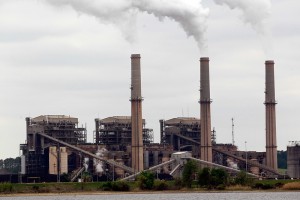 By this point, most of you will have been inundated with opinions and factoids about what President Obama's new "Clean Power Plan" will and won't do about climate change. Bottom Line: while it sets a precedent and an emissions floor for the largest sources of CO2, it does so in a way which turns out to be not so challenging for most states – including Kentucky deep in Coal County.
By this point, most of you will have been inundated with opinions and factoids about what President Obama's new "Clean Power Plan" will and won't do about climate change. Bottom Line: while it sets a precedent and an emissions floor for the largest sources of CO2, it does so in a way which turns out to be not so challenging for most states – including Kentucky deep in Coal County.
That's also true for Texas, where besides being Ground Zero for the fracking boom, we also have plenty of wind power and some solar. According to the EPA, the state must cut an annual average of 51 million tons of carbon to reach its target, a reduction of about 21 percent from 2012 emissions. We're well on our way to achieving most of that reduction with current or planned wind, gas, hydro, and solar. (In what might be a first concession that natural gas shouldn't be a long-term "bridge fuel," some analysts think tweaks performed by EPA prior to the Plan's release give more incentives to adopt real renewables earlier rather than leaning on gas in the interim.)
This is mostly good news. We want the wind and solar economies to grow. The trade-off is that, under Obama's Clean Power Plan, the rise of these technologies and their emissions reductions lets the obsolete East Texas coal plants off the hook because you don't need them to close to meet your CO2-cutting goals.
Five of those obsolete coal-fired power plants surround DFW's eastern side in a half circle (Big Brown, Martin Lake, Monticello, Limestone, and Welsh). They are, without a doubt, the worst examples of fossil fuel-generated pollution in Texas. They're huge emitters of Mercury, Particulate Matter (PM), Sulfur Dioxide (SOx), and Nitrogen Oxides (NOx).
These five East Texas coal plants are projected by the state to still be releasing 150 tons a day of smog-forming NOx pollution in 2018. Because of wind direction and volume, that pollution has a very large impact on DFW air quality – probably more than any other single phenomenon. We need those coal plants to either modernize or close ASAP to help solve our chronic smog problem. But from the initial survey of the policy, the Clean Power Plan is not going to force that outcome.
While the Plan probably signals the end of any new coal plants any time soon, or at least none without CO2 solutions like sequestration or capture, the fate of existing coal plants, especially in a state like Texas, is more ambiguous. More likely, they'll continue to linger on, beneficiaries of friendly state-created policies designed to nullify the requirements of the Clean Air Act, like loosening their PM limits by magnitudes.
Now, you might think that a federal goal that's been mostly accomplished without doing anything new would be a no brainer in Austin, but there are increasingly fewer and fewer brains in Austin. Because the state's environmental agencies are now completely ideologically driven, common sense just isn't a factor anymore. Instead of asking "how can we best solve this problem?" the response is now to deny there's a problem at all and go about ginning up anti-federal hyperbole to better position yourself in the Republican Primary.
Consequently, the Texas Commission on Environmental Quality is seriously considering not turning in a required state plan of how to get the reductions needed by the deadline of 2030. If the state doesn't submit one of its own, then the EPA would write one for them. This has the business community in Texas a little nervous, since they have a lot more influence here than in DC. But citizens, which kind of anti-climate change plan would you rather have Texas abide by – one written by a state agency that denies climate change is happening and is doing everything it can to obstruct policies to prevent it, or one written by a federal agency that's actually acknowledging the obvious and doing something about it?
Regardless of whose plan does what by when, the East Texas coal plants look to be able to ride this federal policy out thanks to an almost two-decade homegrown drive to open up the state to renewables. If we want these coal plants to stop causing problems for us, we're probably going to have to find other leverage points.
One of these leverage points is demanding the state of Texas follow the law and require the coal plants install modern Selective Catalytic Reduction controls as part of the new DFW clean air plan it submitted to EPA this summer for approval. SCR could reduce smog pollution from these plants by 90%. So far, Texas has refused to even acknowledge the need to do so. EPA has requested the state change its mind – without success.
If it wants to, EPA can reject the state's plan for not including these new controls on the coal plants. But we have to encourage them to do so – by petition, and by e-mail.
Consider the five East Texas coal plants the energy sector equivalent of the obsolete "wet" kilns in Midlothian that burned hazardous waste for 20 years. They're technological dinosaurs, on their last legs, but still churning out tons and tons of harmful air pollution as they plod their way to the bone yard. The Clean Power Plan insures they'll be the last of their kind, but it's not a silver bullet.
Ready to Fight Back and Win? Downwinders is about to launch its most ambitious campaign in years
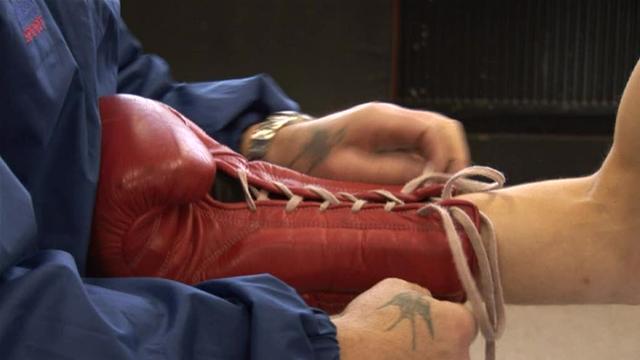
Mercifully, the 2015 Texas Legislative Session is almost over. Since January we've seen cities stripped of their traditional zoning power over oil and gas facilities, citizens' ability to challenge new pollution permits further suppressed, and renewable energy sources singled-out for financial punishment.
But the circus leaves town on June 1, and shortly after that Downwinders at Risk will be gearing up for the largest clean air campaign we've taken on since our fight against hazardous waste burning in the Midlothian cement kilns.
It'll begin with the mid-summer release of the results of a years-in-the-making project that turns the tables on the recent trend to transfer all pollution decisions from local governments to Austin. For the first time, city and county officials in North Texas will have the power to do what, up until now, only state agencies could do.
We don't want to give away too much too soon, but this is by far the single most costly project we've ever sought funding for, and it will have an impact on every major industrial source of pollution affecting Dallas-Fort Worth air quality – the cement kilns, the oil and gas industry and the obsolete East and Central Texas coal plants. And It's being done in a way that makes its results unimpeachable by a hostile state government and industry.
As a kind of sneak peak, below is a small sample of what we're talking about. It's a map of our half of Texas with the DFW metropolitan area outlined in black near the top. It shows the reach and intensity of smog pollution from the five coal plants closest to us. Even though they're 90 to over 100 miles away, they're still able to raise smog levels in central DFW by 4 to 8 parts per billion or more – a huge amount that could make or break our compliance with the Clean Air Act.
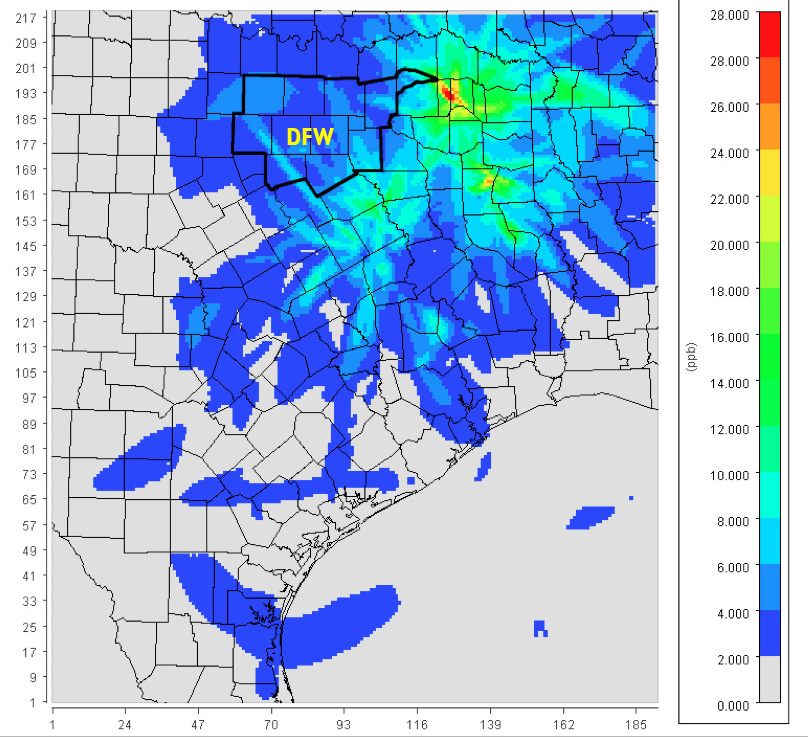 This is a map the Texas Commission on Environmental Quality has the ability to produce, but refuses to. Now, we have the same ability. And we can aim it at any large industrial source of pollution in the region. And we have.
This is a map the Texas Commission on Environmental Quality has the ability to produce, but refuses to. Now, we have the same ability. And we can aim it at any large industrial source of pollution in the region. And we have.
Moreover, the results of our study are being released in tandem with an associated project by Dr. Robert Haley and the University of Texas – Southwestern Medial Center. Together, they'll represent the opening salvos to a sustained, multi-organizational campaign to address DFW's chronic bad air problems.
Armed with this new evidence and having identified some chinks in the armor of the Status Quo, we see a chance to strike a powerful blow for cleaner air and citizen power. We see a chance to win a significant victory. We don't know about you, but after the last five months, we could sure use some victories.
That's not to say winning will come easy. It's still Texas. But we hope you'll agree that one of they keys to our long track record of success is picking the battles and the battlefields that give us better odds.
Every dollar you give goes to fight
for cleaner air right here in N. Texas
Even a Single Day of Air Pollution Increases Stroke Risk
 When environmental health advocates speak about the dangers of dirty air, the effects are often categorized as long term and cumulative. But the more scientists delve into the subtleties of the human body and what outside influences can do it, the more they realize that even short term exposures can be harmful. That's been especially true lately when looking at pregnant moms and the exposure to fetuses in certain stages of development. Not it turns out to true when looking at the other end of the age spectrum.
When environmental health advocates speak about the dangers of dirty air, the effects are often categorized as long term and cumulative. But the more scientists delve into the subtleties of the human body and what outside influences can do it, the more they realize that even short term exposures can be harmful. That's been especially true lately when looking at pregnant moms and the exposure to fetuses in certain stages of development. Not it turns out to true when looking at the other end of the age spectrum.
A new examination of 103 studies involving 6.2 million stroke hospitalizations and deaths in 28 countries published online at the BMJ (British Medical Journal) found that almost every type of industrial air pollution contributed to a higher risk of stroke. And the higher level of exposure to the pollutant, the higher the risk of stroke.
Increases in the levels of Nitrogen Dioxide, Sulfur Dioxide, Carbon Monoxide and fine Particulate Matter were all associated with increases in strikes and hospitalizations. Not surprisingly, the strongest correlations were on the day of actual exposure, but the effects of PM, otherwise known as soot, were longer lasting. Missing from the list is ozone, or plain old smog, which studies have shown increases asthma and heart attacks on its own.
According to the report, strokes account for five million deaths worldwide every year and cause en even greater number of disabilities.
The lead author, Dr. Anoop Shah, from the University of Edinburgh, said that there was little an individual can do when there's a bad air day going on but stay indoors
“If you’re elderly, or have co-morbid conditions, you should stay inside,” he said. But policies leading to cleaner air would have the greatest impact, he said. “It’s a question of getting cities and countries to change.”
A Barnett Shale Manifesto…From Austin
 Sometimes it takes a perspective above the grind of trench warfare to give you a better sense of what the entire battlefield looks like. That's what UT Law Professor Rachel Rawlins has done for Barnett Shale activists with the recent publication of her article "Planning for Fracking on the Barnett Shale: Urban Air Pollution, Improving Health Based Regulation, and the Role of Local Governments" in the new Virginia Environmental Law Review.
Sometimes it takes a perspective above the grind of trench warfare to give you a better sense of what the entire battlefield looks like. That's what UT Law Professor Rachel Rawlins has done for Barnett Shale activists with the recent publication of her article "Planning for Fracking on the Barnett Shale: Urban Air Pollution, Improving Health Based Regulation, and the Role of Local Governments" in the new Virginia Environmental Law Review.
Don't let the academic title fool you. This is a call for a radically new approach to how communities in Texas regulate the risks of fracking, and every other type of heavy industry. We put the link up for the piece on our Facebook page on Saturday based on a quick reading of its commentary on the Flower Mound cancer cluster, but it's more, so much more than that. Among other things, it's a comprehensive rebuttal of every claim of safety and well-being ever issued by the industry or state authorities about the health of residents living in the Barnett Shale, of which the Flower Mound case is only one example. Rawlins has produced a one-stop catalog of each major air pollution health controversy in the Barnett since concerns began to grow in the last decade, with an almost 30-page review of why no industry or government-sponsored study of fracking pollution and its health effects is a satisfactory response to those concerns. Want to convince your local officials that fracking isn't as safe as it's touted? Here's the staggering blow-by-blow commentary to do it.
But all of that documentation is presented in service to making the point that current state and federal regulation of fracking is failing to protect public health, both in design and in practice. Professor Rawlins' solution to this problem is not to give the state and federal government more power to regulate the gas industry. No, it's to turn the current regulatory framework upside down and give more power to local governments to do the things that the state and federal government should be doing.
In making this recommendation, she echoes the strategy that's been driving Downwinders since it was founded – that the best way to regulate pollution problems is at the local level where the most harm is being done, and it should be directed by the people being harmed. This is what drove our Green Cement campaign that closed the last obsolete wet cement kiln in Texas. This is what fueled our campaign to close down the trailer park-come-lead smelter in Frisco. And it's what was behind the recent Dallas fights over drilling. In each case, it wasn't Austin or Washington DC that was the instrument of change – it was local governments, pressed by their constituents, flexing their regulatory powers. The same thing is driving activists in Denton who are organizing the ban fracking petition drive and vote.
This strategy avoids battles where industry is strongest – in the halls of the state capitol and in DC, where citizens are outspent millions to one. Instead, it takes the fight to neighborhoods where the harm is being done or proposed, where people have the most to lose, where the heat that can be applied to elected officials is more intense. Citizens will still get outspent, but the money doesn't seem to buy corporations as much influence among those actually breathing the fumes of the drilling site, or smokestack.
Particularly now, with corporate-friendly faux-Tea Party types in control of state government and the House of Representatives in DC, there is little room for grassroots campaigns to make a difference by passing new legislation. Even if by some miracle a few bills did pass, their enforcement would be up to the same state or federal agencies that are currently failing citizens. Local is more direct, and more accountable. Professor Rawlins agrees, and spends most of the rest of her 81-page journal article citing the ways in which local control of fracking in the Barnett Shale is hampered by the out-dated top-down approach to regulation, and what should be done to fix that.
Included in her recommendations are two long-term Downwinders projects: Allowing local governments to close the "off-sets" loophole for the gas industry that exempts them from having to compensate for their smog-forming pollution in already smoggy areas like DFW, and creating California-like local air pollution control districts that could set their own health based exposure standards and pollution control measures without having to go through Austin or DC.
If there's a single major fault in Rawlins's analysis, it's that she believes more local control of pollution risks is itself dependent on action by an unwilling state government. But Downwinders and others have shown that isn't true. Our most significant and far-reaching victories – from the closing of the Midlothian wet kilns to the new Dallas drilling ordinance – have all taken place while Rick Perry was Governor and the state legislature was in the hands of our opponents. We did these things despite Austin, not because we had its permission. Local zoning laws, local permitting rules, local nuisance acts, and other local powers are under-utilized by both residents and their elected officials when it comes to pollution hazards.
The same is true now of Downwinders' off-sets campaign aimed at the gas industry. We think we've found a way to avoid the "preemption" argument that would keep local governments from acting on smog pollution from gas sources by aiming the off-sets at Greenhouse gases – an area of regulation Texas is loathe to enter. By targeting GHG reduction, we also reduce a lot of toxic and smog-forming air pollution. It's a back door way, but it accomplishes the same goal. It's going to be up to Texas activists to sew similar small threads of change through an otherwise hostile political environment.
Even given that flaw, Professor Rawlins' introduction to her article is the most concise summary of the air pollution problems caused by gas mining and production in the Barnett, as well as the most credible call to action for a new way of doing business there. Here it is reprinted in full for your consideration:
In the last decade hydraulic fracturing for natural gas has exploded on the Barnett Shale in Texas. The region is now home to the most intensive hydraulic fracking and gas production activities ever undertaken in densely urbanized areas. Faced with minimal state and federal regulation, Texas cities are on the front line in the effort to figure out how best to balance industry, land use, and environmental concerns. Local governments in Texas, however, do not currently have the regulatory authority, capacity, or the information required to closet he regulatory gap. Using the community experience on the Barnett Shale as a case study, this article focuses on the legal and regulatory framework governing air emissions and proposes changes to the current regulatory structure.
Under both the state and federal programs, the regulation of hazardous air emissions from gas operations is based largely on questions of cost and available technology. There is no comprehensive cumulative risk assessment to consider the potential impact to public health in urban areas. Drilling operations are being conducted in residential areas. Residents living in close proximity to gas operations on the Barnett Shale have voiced serious concerns for their health, which have yet to be comprehensively evaluated. Given the complexityof the science, and the dearth of clear, transparent, and enforceable standards, inadequate studies and limited statistical analysis have been allowed to provide potentially false assurances. The politically expedient bottom line dominates with little attention paid to the quality of the science or the adequacy of the standards.
Determining and applying comprehensive health-based standards for hazardous air pollutants has been largely abandoned at the federal level given uncertainties in the science, difficulties of determining and
measuring “safe” levels of toxic pollutants, and the potential for economic disruption. Neither the state nor the federal government has set enforceable ambient standards for hazardous air pollutants.Identifying cumulative air pollution problems that may occur in urban areas, the State of California has called upon local governments to identify “hot spots” and to consider air quality issues in their planning and zoning actions. In Texas, however, preemption discussions dominate the analysis. Any local government regulation that might provide protection from toxic air emissions otherwise regulated by the State must be justified by some other public purpose.
Texas should consider authorizing and encouraging local level air quality planning for industrial activities, similar to what California has done. Care should be taken to separate these facilities from sensitive receptors and “hot spots” that may already be burdened with excessive hazardous air emissions. Given the difficulty of the task, there is also an important role for the state and federal governments in working to establish ambient standards for hazardous air pollutants, as well as standards for health based assessment and public communication. The uncertainty inherent in any of these standards should be made clear and accessible to local governments so that it may be considered in making appropriate and protective land use decisions. Texas should consider allowing local governments to have the power to establish ambient air quality standards, emissions limitations, monitoring, reporting, and offsets for hazardous air pollutants, following the model applied to conventional air pollutants pursuant to the federal program.
Professor Rawlins' article provides Barnett Shale activists with a new map to guide them toward more effective action. We'd all do well to study it and pick local battles that promise to contribute toward its realization.

